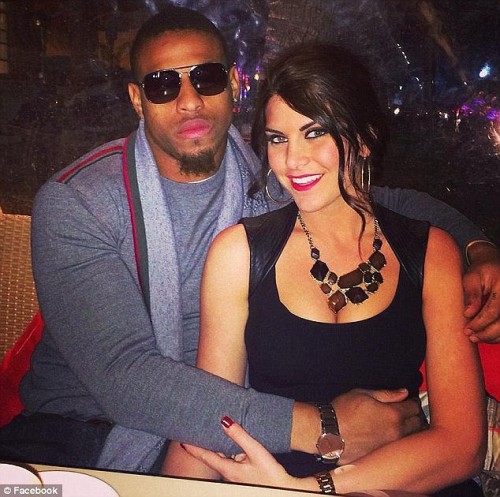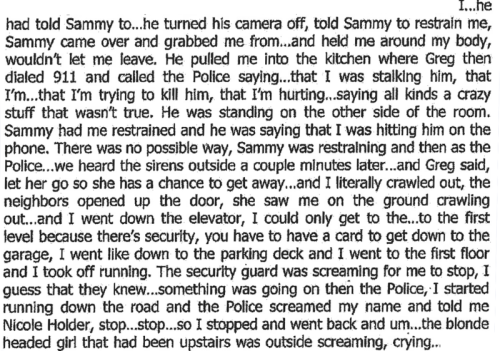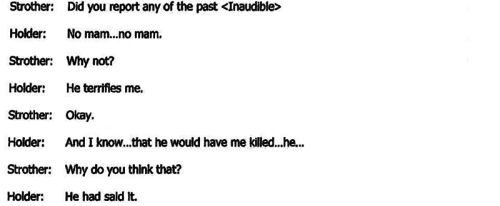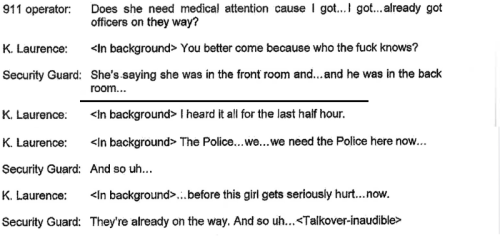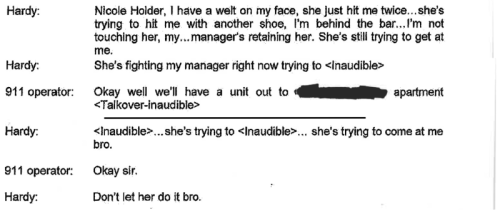Barefoot and frightened, Nicole Holder walked as fast as she could through the darkness, and the moment she saw the cops she ran. She headed west on Fifth Street toward North Church, away from the Charlotte., N.C., apartment of Greg Hardy, a star defensive end then with the NFL’s Carolina Panthers. Minutes earlier he had, she said, thrown her against a tile bathtub wall, tossed her on a futon covered in assault rifles, and choked her until she told him to “kill me so I don’t have to.”
Officer Jeffrey Kendrick ran after her, ordering her to stop. Holder turned and walked toward him, and Kendrick asked her why she was crying.
“It doesn’t matter,” she told him. “Nothing is going to happen to him anyways.”
A year and a half after Hardy was arrested and charged with attacking Holder, it’s clear that she was mostly right. Last year, Hardy was convicted of assault in a bench trial, but the charges were dismissed on appeal and, it was reported yesterday, expunged. He missed more than a season of football, but went on to sign with the Dallas Cowboys, for whom he’s become a bigger star than ever despite (or perhaps because of) a series of incidents ranging from making sexist comments in a press conference to going after a coach on the sidelines. Jerry Jones, the Cowboys’ billionaire owner, calls him a “real leader” who has the respect of all his teammates and inspires America’s Team.
Unlike Ray Rice, the former Baltimore Ravens star who was filmed knocking his future wife unconscious in an elevator, Hardy hasn’t become a pariah. That’s partly because he’s more valuable on the field, but also because of the perception that nobody knows what really happened that night. Hardy won’t talk about it; Holder has gone quiet ever since, prosecutors say, she received a settlement, which contributed to the criminal case against him falling apart. And, crucially, no photos or videos ever came out. Police and prosecutorial records that detail what happened that night have largely been kept from the public—though not from the NFL.
The popular sporting news site, Deadspin, has obtained hundreds of pages of those records, some previously reported—police reports, interview transcripts, and more. Photos, dozens of them, show bruises over much of Holder’s body, including her back, her arms, her legs, her chin, her neck, and even her foot.
Below are some of those released by Deadspin, but not all, taken of Nicole Holder were within 24 hours of when she says Hardy attacked her.
Many may find the following photos disturbing to look at, please advise and advance with caution.
(Click images to enlarge)
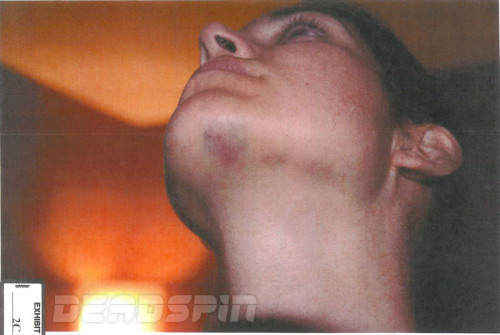
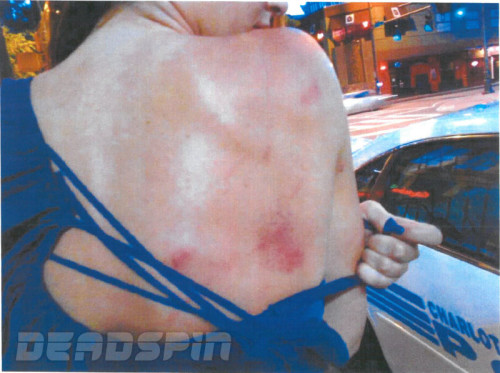
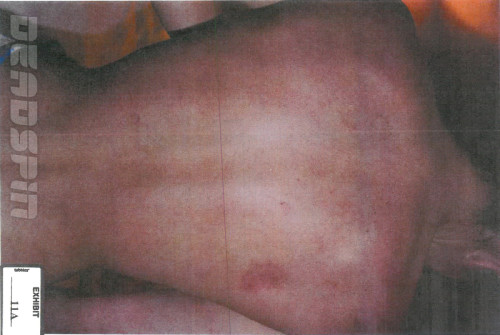
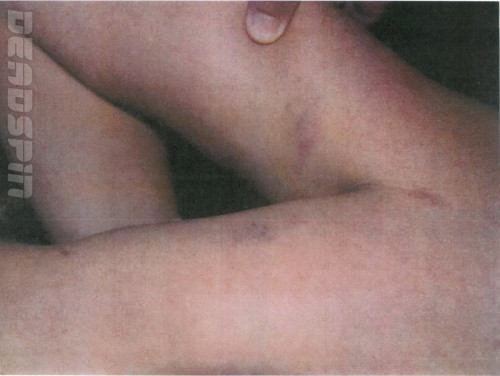

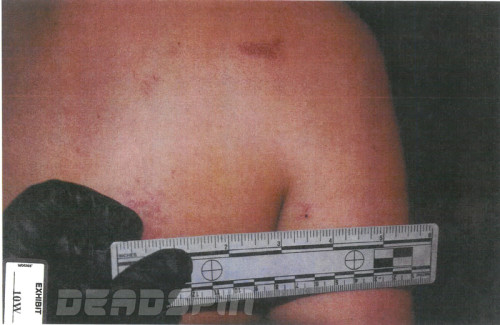
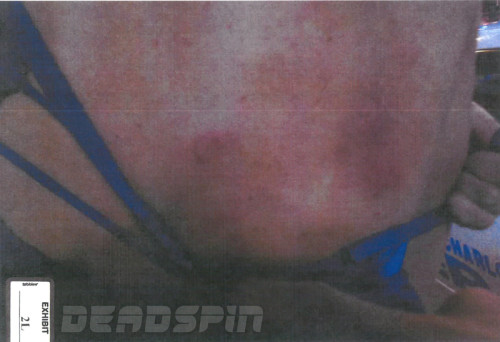

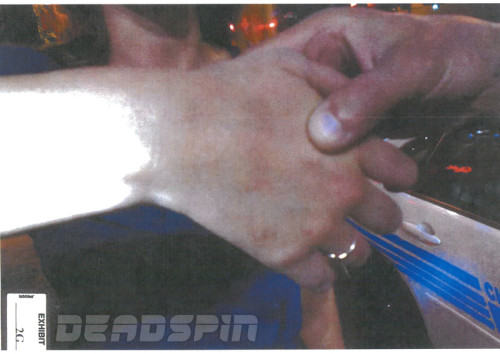
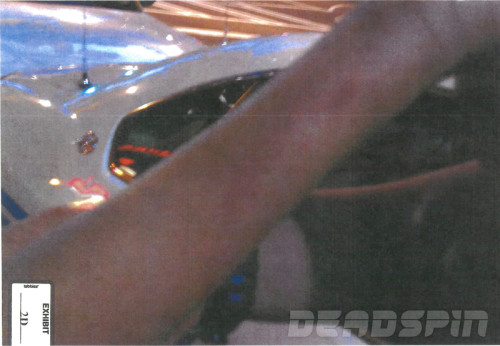
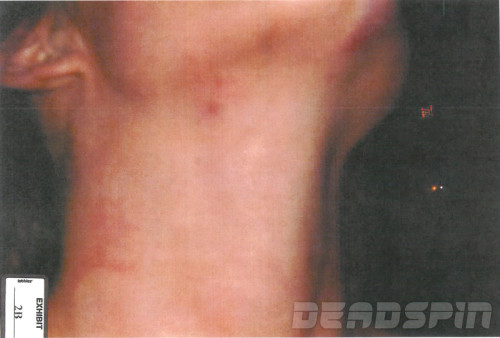

Here is a photo posted to snap chat by Iwanicki which shows just a few of Hardy’s high powered assault rifles.
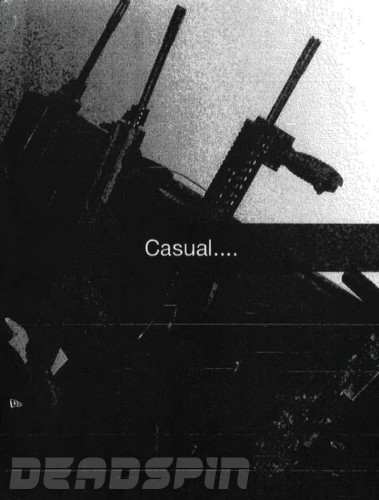
Below is a police list of the list of guns obtained in the seizure.

The following includes reports written by Deadspin with evidence obtained by such.
The Relationship
Greg Hardy and Nicole Holder met in 2012; Hardy, then a second-year player for the Carolina Panthers, was seeing her roommate. The two started dating in September 2013, while Hardy was on his way to his first Pro Bowl, and things got serious quickly. Holder said she moved in that November, which Hardy denied. Either way, she had the keys to his home, an apartment in the Ivey’s, a renovated mixed-use building just two and a half blocks away from Suite Charlotte, where Holder tended bar.
Things got bad, Holder said, starting around Christmas. He started asking Why did you do this to us? and calling her a slut, Holder told a detective. The details of the breakup depend on which person answers the question. Holder says he kicked her out of the apartment on the first of March; Hardy said it was right after the Pro Bowl because he was tired of arguing and needed to focus on football. It wasn’t quite over, though, and come May, Holder and Hardy were still in each other’s lives.
“It was very up and down. It always seemed like there was an issue,” her friend and co-worker Laura Iwanicki would later say in court. “It was either really good or really bad, and I felt I didn’t think there was any in between.”
The Night Of The Incident
On May 12, 2014, Holder got a text from Sammy Curtis, Hardy’s personal assistant and manager, asking her and Iwanicki to come hang out at Hardy’s apartment that Sunday night.
Curtis is a familiar type, a longtime friend of Hardy’s who moved to Charlotte two years after Hardy was drafted out of Mississippi by the Panthers so that he could, as he later said in court, “help Greg develop businesses and just with his day-to-day activities, relieve stress off of him so he could perform better on the football field.”
The two women got ready and arrived at Hardy’s apartment about 8 p.m., joining up with Hardy, Curtis, and Tormarco “Marco” Harris, another member of Hardy’s entourage, along with two other women the men had met that afternoon. Iwanicki noticed a pile of guns on the futon, took a picture, and shared it on Snapchat with the caption “Casual …”
Holder brought a bottle of champagne, and the group drank and did shots until Hardy knocked over a glass, shattering it on the floor. Curtis called out, “Party foul!” Soon after this, Hardy left for his recording studio; the rest of the group drank, then headed over to Blackfinn, a bar where they hung out and drank even more. Holder and Iwanicki, according to Holder, did a bump of cocaine. (Iwanicki pleaded the Fifth to the cocaine question in court). Then Holder got a text from Hardy, asking her and Iwanicki to meet him at the Blind Pig, a dive bar known for arcade games and skee ball. The two women headed over, and Hardy arrived soon afterward with another assistant of his, Rachel Shipley, aka Shay. Iwanicki wanted to go to Bubble—a bar advertising itself as “a premium establishment that stimulates the senses”—and so they relocated yet again. Between it all, Holder estimated they went through four bottles of champagne, as well as shots of tequila and mixed drinks.
“To top everything off,” Holder would later testify, “a Nelly song came on.”
(Nelly had previously been a point of contention between Holder and Hardy. The two had plans to travel on her birthday in March, she told police, but he cancelled, and so she spent her birthday at her job and walked out with Nelly. From there, she went with the rapper to the Ritz-Carlton. Hardy, she told detectives, found out; she wasn’t sure how, though she believed one of his Panthers teammates saw her leaving Suite Charlotte with Nelly and told him.)
It was about 3 a.m. when group decided to leave without Iwanicki, who had slipped away and was with other friends at the bar. Hardy drove one car, Harris another, and Curtis took Shipley home, according to Curtis’s testimony in court, before going back to Hardy’s place as well. When the partying was done, Harris and Laurence were asleep in the master bedroom, Curtis was asleep on the living room couch, and Hardy joined Holder in a smaller room, an office with French doors that acted as a bedroom with a bathroom attached.
“His face, it was just blank …”
“It all happened very, very quickly,” Holder told police. “None of it really made much sense.”
She and Hardy were on the bed inside the apartment’s smaller bedroom, getting along fine, when Hardy started bringing up the past. He called her a slut, she said, and accused her of ruining their relationship.
“I tried to get up, he pushed me,” she said, “then I started fighting back, he threw me into the bathroom, I hit the back of the shower wall and fell into the bathtub where he pulled me out.”
He dragged her out by her hair and picked her up again, she said, throwing her onto the futon, which had several weapons—what she described as “guns from … the Army or … I mean like from video games”—on it. She landed on top of the rifles and then fell onto the floor. In her telling, he stood above her and strangled her with both his hands. She would later tell Detective Faye Strother that she thought she was going to die. “His pupils were tiny,” she said. “I mean he looked … crazy.”
The following are the recorded accounts of an interview Hodler had with detective Faye Strother:
This is when Hardy snapped out of it, or at least when the worst was over. She said that Hardy jumped off of her, reached into his pocket, pulled out a cell phone, screamed for Curtis to come into the room, and started filming. (None of the other records I received mention any cell phone footage.) She told one officer that night that this was when Hardy began “agitating her several times trying to get her to flip out on him.” Curtis came in, grabbed her from behind and, restraining her in something like a bear hug, moved her to the kitchen.
Curtis, Holder said, didn’t say anything; he just did what Hardy told him. She struggled against him as Hardy called 911, claiming to have been the victim of an assault, before being let go. Holder would later give her accounting to police:
This was allegedly not the first time their relationship got violent. Holder told police that it had happened two or three times before, but played it down. “It wasn’t like I got hurt,” she said. “There was no bruising.”
“Security Acted As If Nothing Was Going On”
Kristina Laurence was wide awake one room over. The then-24-year-old had met Hardy and Marco Harris that day when she waited on them at her restaurant and exchanged numbers with them. She was part of the group that had started the night in Hardy’s apartment, where Holder was cold to her, and ended the night with the group at Bubble. She was, according to a statement she gave police, asleep in the apartment’s main bedroom with Harris when she woke up to yelling.
A detail from Kristina Laurence’s account to police reads as follows:
I overheard a friend yell, ‘What are you going to do, break my arm?!’ She was screaming and crying. I don’t recall what he said but it sounded like a body being pushed around/body slamming. The body slamming went from the hallway to the kitchen to the living room. As all of this is going on, I’m still lying in bed. The body throwing had been going on for a few minutes then subsided shortly. Then the arguing began again and I heard Greg say, I’m calling the police.
Marco noticed me awake and listening and he told me to go back to sleep. I began putting my clothes on and Marco said, ‘Where are you going?’ I told him I’m getting the fuck out of here … I heard everything. Marco said, ‘You didn’t hear shit and she wanted it all.’ I then ran out of the apartment. I went downstairs to notify the security and he acted as if nothing were happening.
At some point, this changed, and security called police. A transcript of the 911 call backs Laurence’s account as described in a police report, in which, “because security was dancing around the subject, she then took the phone and began telling dispatch what was going on.”
The Second 911 Call:
Hardy also called 911. It’s unclear which call came in first—the one from Hardy or the one from Laurence—because the official transcripts aren’t timestamped. In his initial version of events, given while Curtis was restraining Holder and while Holder was lashing out, Hardy makes it sound like he was being assaulted by a girl that a friend of his had brought home:
Hardy would reiterate a version of this story in a statement he gave to police later on that night, that a woman attacked him. When asked to explain Holder’s injuries during his bench trial, he and Curtis would testify that Holder had jumped into the bathtub, then thrown herself on the couch, and then went crazy trying to attack Hardy. Hardy’s lawyer, Chris Fialko, would assert that Holder must have caused the injuries to herself. If the 290-lb. pass rusher had really wanted to hurt a woman who weighed well less than half what he did, his argument went, the damage would have been a lot worse.
Police took pictures of three injuries to Hardy that night. During his bench trial, prosecutor Jamie Adams pointed out that one was a mark he’d had on his face in pictures from before May 12. Within 24 hours, police would go on to take and gather dozens of photos of injuries to Holder. First, though, they had to convince her to talk.
Officer Jeffrey Kendrick, one of the first to arrive on the scene, saw Laurence walking out the Ivey’s front door, and Holder running. He and a second officer ran after Holder and told her to stop, which she did. She then walked back to the officers, who both wrote that she was visibly upset.
Officer Andrew Prentice asked Holder where the scratches on her arm came from. She said nothing had happened all. Later, she said she did it to herself. She refused to give a statement. One person was talking though—Laurence.
“Laurence,” wrote Officer Abraham Kim, “advised that she was upset because she heard Holder being beat and now Holder does not care about what happened. Laurence advised that she would tell officers everything because the assault that occurred needed to be documented.”
No matter how much Holder told them nothing happened, the officers wouldn’t leave. As they stood on the corner of Tryon Street and Fifth Street, next to the Ivey’s building, Sgt. Ivan Reitz tried again. He asked her if she could tell him what happened. She said nothing happened, then said, “I fell down the stairs.” He asked if officers could take pictures of her injures; she shook her head and quietly said, “No.” When Reitz walked toward Laurence, who was across the street talking to another cop, Holder told him, “That girl is crazy.” With 6 a.m. drawing near, police had taken some photos of her injuries, but Holder still refused to talk. She came close once, but stopped when she saw Officer Christopher Martin turn on an in-car recording device.
After going off to make a phone call, Reitz returned and noticed that Holder’s bruises “were becoming much more visible.” She also was starting to open up to Martin, who had stayed with her while the other officers investigated. But she wasn’t willing to give an official statement. Reitz told Martin to start a report with what Holder had said, told two others officers to get warrants for Hardy, and had Prentice take Holder home—with his patrol car’s recording device turned on.
In a separate report, Martin summarized what Holder told him that night. Martin talked to Holder about why it was important for her to give a statement about what happened. She “admitted to me that the suspect ‘beat the hell’ out of her but would not elaborate,” he wrote.
She also told Martin “if she ever did anything to damage his career that he would kill her.”
Holder was taken home about 7 a.m., but when police went to her apartment later on in the afternoon, she was gone. They got a call from her then-lawyer at 9:04 p.m., saying she was afraid to go home and was instead was staying at a Sheraton after visiting a local hospital, where more photos were taken of her injuries. At her hotel, she gave a full interview to police and let them take photos of her injuries.
When the officers went up to Hardy’s apartment, they found him on a couch with Sammy Curtis nearby. Officer Prentice noticed a rifle leaning on the windowsill; Hardy said it was an air rifle and the police report says that from their distance, about 10 feet away, it did look like one. Asked if he had any other weapons, Hardy said he had a handgun in his bedroom. Asked again, Hardy said that the only other weapon he had was the handgun.
Where were they during the attack? When asked in court what happened to all the guns that Holder and Iwanicki testified to seeing, Hardy said, “They got put up.” Prosecutor Adams pointed out that at least half an hour passed before officers went up to the apartment, giving Hardy and Curtis plenty of time to clean up. Why did police take so long to go up to Hardy’s apartment? Overall, the documents portray a group of officers who took the case seriously and investigated it rigorously. But my emails and voicemails asking for comment from the Charlotte-Mecklenburg police on this issue, among others, were not returned.
The guns weren’t the only part of Hardy’s story that evolved that night. The bit from his 911 call about how Holder was a girl a friend had brought home was gone. A report taken by Officer Prentice noted that Hardy said he didn’t know that Holder would be at the Blind Pig, then said he did. (Holder had shown another officer a text asking her to meet Hardy there.) Hardy said Holder was the only person left in the apartment in his written statement, ignoring that Harris and Laurence were there.
More significantly, Reitz called the police department’s communications supervisor after hearing Hardy’s story and asked her to listen to the 911 call and call him back to see if it matched what Hardy had told him. She told Reitz “it did not sound like what I had described to her.”
Reitz talked to Hardy again, asking if he could talk to him at the station and get a statement from him. He declined, saying he “did not believe it was a good idea to go to the police station.” The police took his written statement, took a few pictures of his injuries, and headed back downstairs. One officer saw Harris as he was leaving the bedroom inside Hardy’s apartment. Prentice asked Harris—who had, Laurence said, told her that she hadn’t heard anything and that Holder had been asking for it—if he heard or saw anything. He said no. He later changed his mind about that, and gave an interview to police in which he denied having told Laurence to ignore what happened, insinuated that Holder was a drunk and a gold digger, and said he was pretty sure Hardy never hit Holder because “it didn’t look like she was smacked.”
Why Hardy Was Not Charged
Despite all the notes taken by cops, despite Holder’s moving interview, and despite Laurence’s cooperation, all of which were enough to secure Hardy’s conviction at his July 2014 bench trial, it all fell apart on appeal.
Holder disappeared. District Attorney R. Andrew Murray later told the court in his Feb. 9 dismissal form that his office and law enforcement across North Carolina had conducted a thorough search, even “conducting surveillance of a new residence where she was believed to be living.” Her relatives and her lawyer refused to help. She could be found on Facebook, where pictures dated since the trial show her in Colorado, New York, Paris, and, yes, Charlotte.
Murray added that “The State further has reliable information that Ms. Holder has reached a civil settlement with the Defendant.” How much nobody has said.
With Holder gone, prosecutors had the choice of dismissing the charges or trying to introduce Holder’s statements as part of the trial. Murray’s office reviewed the interview that Holder gave to police and compared it to a transcript of the bench trial. (District court criminal trials aren’t recorded by a court reporter in North Carolina, Murray wrote, but Hardy’s defense team had hired one and eventually agreed to let prosecutors see it.)
“In comparing the prior statement with Ms. Holder’s District Court testimony, the State concluded that, in her absence, it did not have sufficient legal basis upon which to introduce the initial statement she provided to law enforcement,” Murray wrote.
What does that mean? My repeated attempts to reach Murray for comment got nowhere—he never returned a phone call or email I sent. The assistant district attorney who handled the case, Jamie Adams, has since left the office; I wasn’t able to reach her. At the time, the News & Observer reported that, “Several legal experts around town speculated that prosecutors spotted inconsistencies that prevented them from building their case around Holder’s former accounts.”
There are minor inconsistencies in Holder’s versions of events—in court, for instance, she added a part about Hardy ripping a necklace off of her and throwing it in the toilet, then slamming the toilet lid on her arm repeatedly when she tried to get the necklace, and left out the part where he takes out a cell phone—but the overall order of events stays pretty much the same. None of the inconsistencies in her tellings are nearly as significant as the discrepancies in the various versions of events that Hardy has given.
At any rate, the case was dropped, Hardy was declared legally innocent, and he went back to the NFL a bigger star than ever. (Both the NFL and the Dallas Cowboys declined to comment.) In the end, Holder was right. Her own prophecy came true, despite her own attempts to prove it wrong.
Greg Hardy was suspended all of the reminder of the 2014-2015 NFL season and then picked up by the Dallas Cowboys, a move which of course was highly criticized. Hardy was suspended for the first 4 games of this season but is now playing.
The DE came under more fire after he was involved in a verbal altercation with Cowboys WR Dez Bryant, and in the same game got into another verbal altercation with a Dallas coach that did involve body contact, but featured Hardy slapping away his coach’s clipboard. Team owner and GM Jerry Jones commented after the game, backing up his player, alluding to him as a “great leader” and worthy of a contract extension, comments which bewildered the media and NFL fans everywhere.


